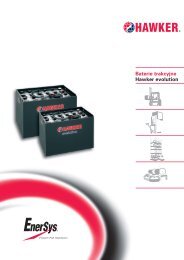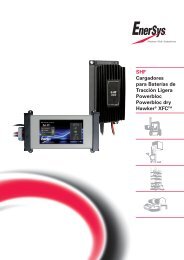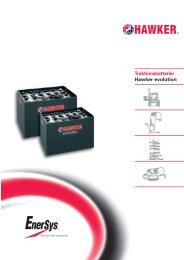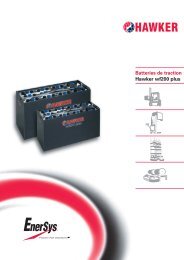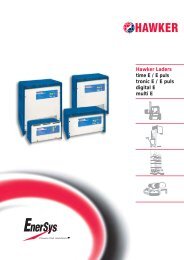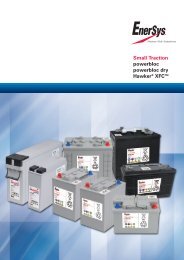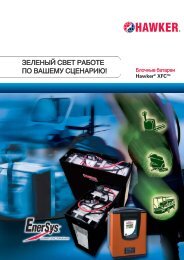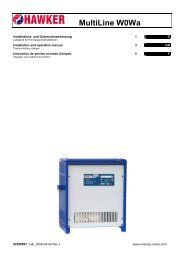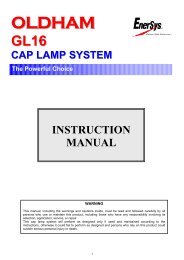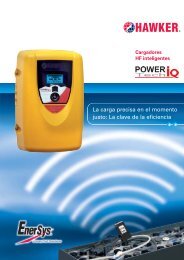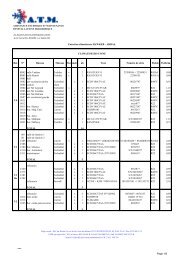Create successful ePaper yourself
Turn your PDF publications into a flip-book with our unique Google optimized e-Paper software.
Mature technology with new features ...<br />
Common features<br />
Ah-balancing<br />
• The special <strong>Hawker</strong> balancing charging<br />
technology warrants a full charge<br />
without overcharge at all depth of<br />
discharges and mains voltage<br />
fluctuations.<br />
• The <strong>Hawker</strong> state of charge optimisation<br />
provides a stable charging factor<br />
even with deviation of the nominal<br />
temperature of 30°C.<br />
Fully automatic charging<br />
• The charge is automatically started<br />
8 seconds after the connection of the<br />
battery with a self test of the charger.<br />
• Switching on of the charger cannot be<br />
forgotten and a charged battery is<br />
always available.<br />
Equalising charge<br />
• Depending on the application of the<br />
battery one of three programmed<br />
equalising charges are automatically<br />
started.<br />
• 20 hours after the start of the charge an<br />
equalising charge is initiated. 12% of<br />
the nominal capacity is charged.<br />
Hereby application related differences<br />
in the cell assembly are securely compensated,<br />
always an optimised capacity<br />
of the battery is available.<br />
• In case of a fixed assignment of<br />
battery and charger after every fifth<br />
opportunity charge or after 15 full<br />
cycles an equalising charge is started<br />
one hour after the end-of-charge<br />
(12% Cnominal). • A manual equalizing charge, wich can<br />
be activated anytime after a charge has<br />
been started, will begin one hour after<br />
the end-of-charge (12% Cnominal). Refresh charge<br />
• After end of charge the charger is<br />
periodically switched on to maintain<br />
the battery capacity.<br />
Sulphation wait state<br />
• Sulphated batteries are detected, the<br />
measurement for the calculation of the<br />
charged Ah is released after 15 minutes.<br />
Pre-selectable charging factor<br />
• Deviating from the basic setting the<br />
charging factor can be adjusted to suit<br />
the respective application.<br />
Safety-cut-off function<br />
• The maximum possible charging time is<br />
limited by a supervisory safety control.<br />
Stop-key<br />
• The stop key allow a disconnection of<br />
battery and charger at any time.<br />
Automatic charger function test<br />
• With the stop key before start of<br />
charging an active functional check of<br />
the charger can be initiated, which<br />
automatically will switch over to<br />
charging.<br />
Desulphation and<br />
commissioning charge<br />
• Deep discharged batteries (strong<br />
sulfatation as consequence of a<br />
discharge of more than 80% C5) need<br />
additional charge in order to minimise<br />
the adverse consequences.<br />
• This also applies for new batteries,<br />
with no commissioning charge or<br />
batteries which have been stored for a<br />
long time.<br />
• With this charging program a defined<br />
Ah-capacity can be charged<br />
additionally.<br />
LED charging state status indications<br />
• The status of the charging state is<br />
signaled additionally by powerful<br />
bright LEDs.<br />
Charging active: LED “ON” lighted<br />
Battery 80% charged: LED “80%” lighted<br />
Battery 100% charged: LED “100%” lighted<br />
Charging <strong>puls</strong>e aktive: LED “ ” lighted<br />
Mains black out, wrong battery nominal<br />
voltage LED “Fault” lighted<br />
8



